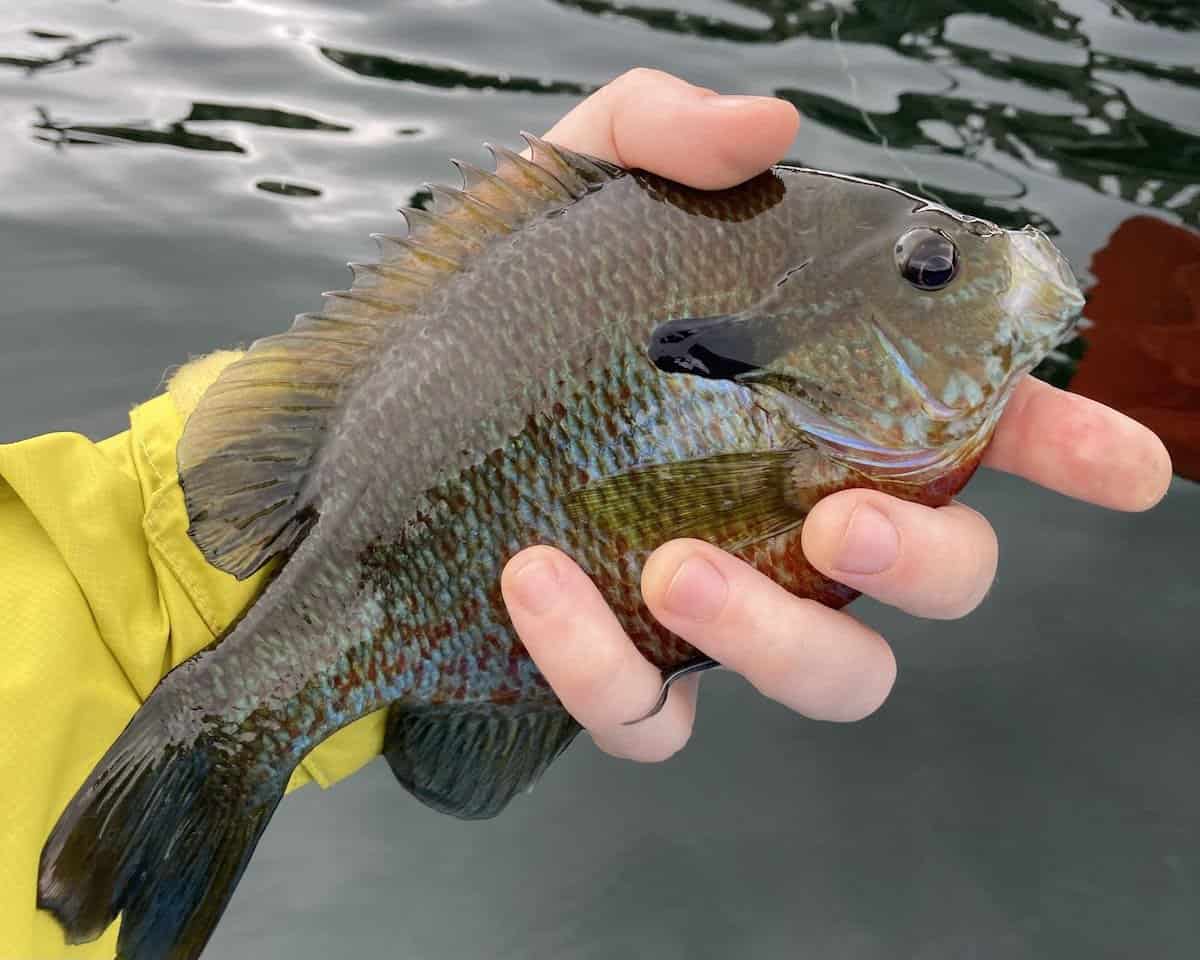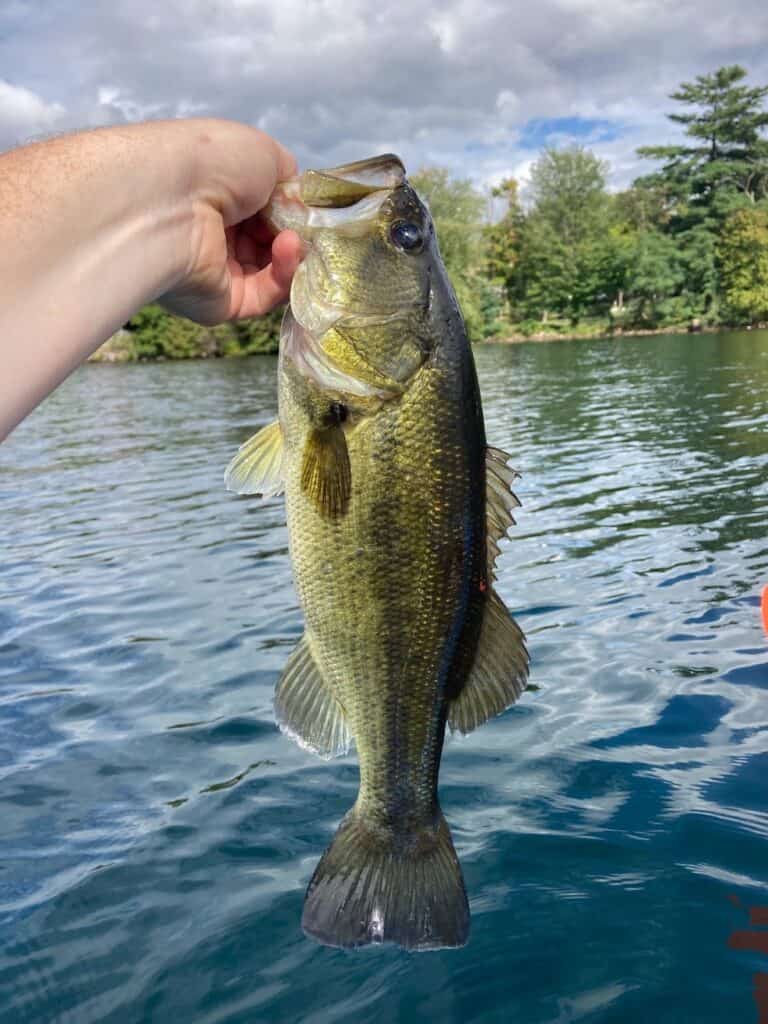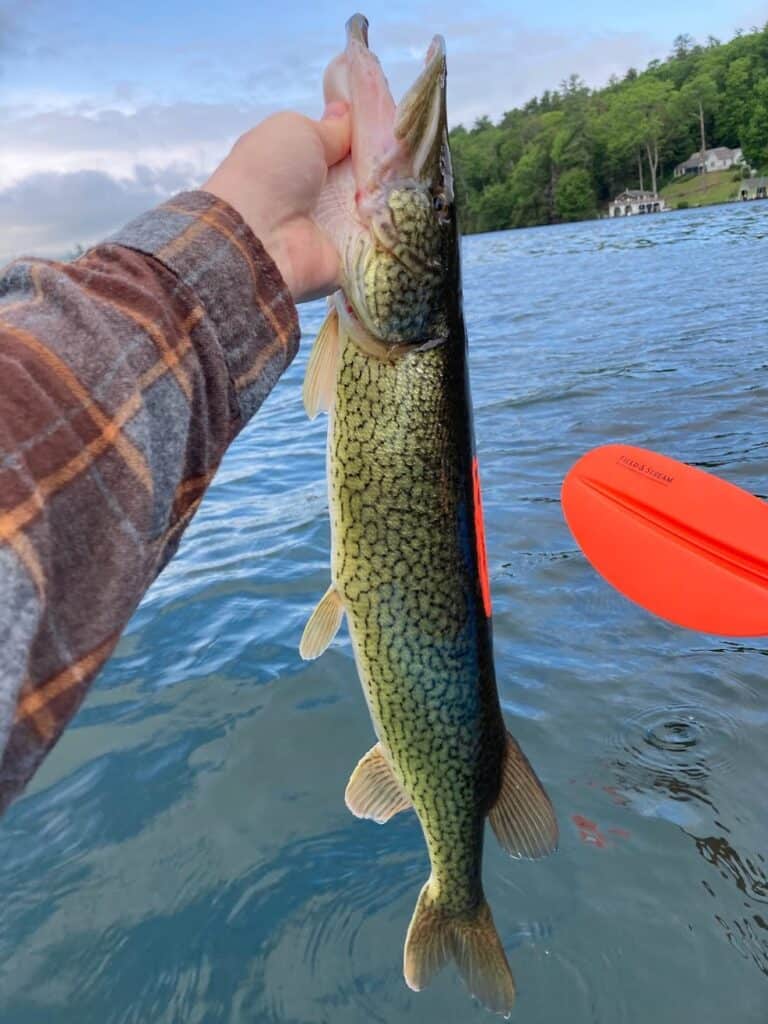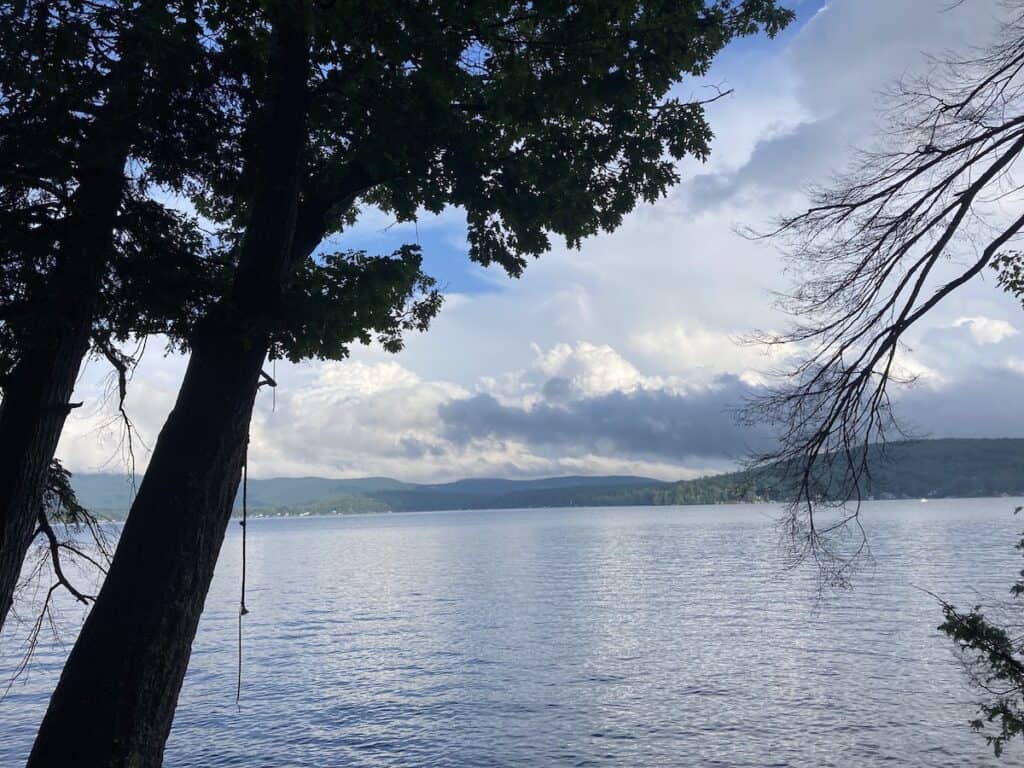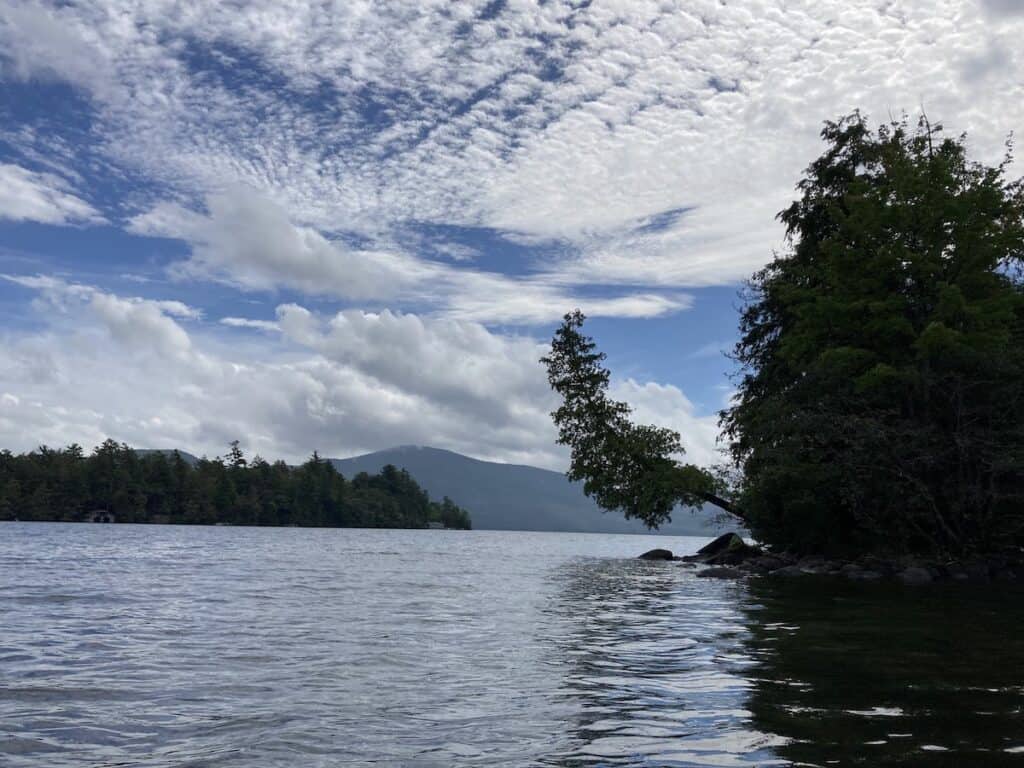With crystal clear waters surrounded by the rolling foothills of the Adirondack Mountains, Lake George is known as one of New York’s most picturesque lakes. Thomas Jefferson, visiting in 1791, called Lake George the most beautiful lake he had ever seen.
But for anglers, the scenery is just icing on the cake. Beneath its surface, Lake George supports a diverse two-story fishery in which both warm- and cold-water game fish thrive.
A long, narrow natural lake spanning 28,451 acres, Lake George is 187 feet deep at its deepest point. Shallow portions of the lake, especially in the south end, support extensive and healthy weed beds, but the lake also has excellent deep, rocky structure.
Steep drop-offs, many within casting distance of shore, plummet rapidly to depths of 50 feet or more. The lake also offers submerged shoals, shipwrecks, ledges and rock piles, as well as over 180 islands.
Many of those islands are clustered in an area near the center of the lake known as the Narrows, which divides the more populated southern half of Lake George from the more undeveloped northern half.
Both basins of this 32-mile-long lake offer excellent fishing for largemouth and smallmouth bass, northern pike and pickerel, lake trout, landlocked salmon, and a variety of panfish.
Largemouth & Smallmouth Bass
Lake George is one of New York’s most consistently excellent bass lakes. The lake kicks out tremendous numbers of healthy 2- and 3-pound bass—both largemouths and smallmouths—and 5-pounders of both species are available.
Smallmouth bass are somewhat more abundant than largemouths in Lake George. But largemouth bass, favoring shallower, weedier habitats that are closer to shore, are more frequently caught by many anglers.
The southern half of the lake, which is the half most heavily fished due to it being more heavily developed, features broad flats at the southernmost end and a fringe of shallow water along the east and west banks where weeds grow prolifically in summer.
This is largemouth heaven. There aren’t a lot of lily pads or emergent vegetation, so you can do quite well by working spinnerbaits, shallow-diving crankbaits and soft jerkbaits over the tops of the weeds.
Bass spawn from late May to mid-June, and bays offer prime fishing that time of year. Lower Lake George offers miles of docks and boat houses along the banks, and dock fishing with wacky worms and tubes is a great tactic that can produce largemouths all summer long.
The stretch along the west side of the lake around Bolton Landing is also great for beating the banks for largemouths. Northwest Bay, just north of Bolton Landing, is a major largemouth stronghold, as is Dunham’s Bay down by Lake George Village.
Smallmouth bass, ever more comfortable in rocky environs, are often found slightly deeper than largemouths. Once they’ve finished spawning, look for them along drop-offs, rocky reefs and main lake points.
Smallmouths can be caught shallow, especially in the morning and evening, but depths in the 20- to 40-foot range are often best. Try tube jigs, diving crankbaits, and finesse soft plastics on drop-shot rigs.
Long Island, Diamond Island, Wood’s Point and Plum Point are prime smallmouth spots toward the south end of Lake George. Smallmouth bass are also abundant throughout the islands and reefs that dot the Narrows and around Shelving Rock. Anthony’s Nose and Rogers Rock are prime spots farther north.
Catch More Bass
Check out these resources if you want to catch more bass in the Empire State.
Lake Trout
The DEC stocked lake trout in Lake George for decades, but the fish have taken to natural reproduction so successfully that stocking was discontinued several years ago. Today, lakers ranging from 20 to 24 inches are common, and fish up to 20 pounds are available.
During most of the year, lake trout are deep-water dwellers. Depths ranging from 70 to 120 feet produce the most fish. When the lake is still cool in spring, you might find them throughout the water column, but in general, it pays to focus on fishing just off the bottom.
Trolling and jigging are both effective, the former being the best search tactic and the latter coming into play when anglers locate a productive spot. Most local guides start by trying to mark fish on their electronics.
If that isn’t an option, start off by blind trolling some of the more likely areas, which include southeast of Dome Island, southwest of Pilot Knob, and off the point of Tongue Mountain. Deep areas near drop-offs throughout the northern basin can also be productive.
Slow trolling with downriggers often works best, and around 100 feet is a good starting depth. Lake trout feed on smelt, ciscoes and sculpin, typically cruising just off (but not directly on) the bottom.
Umbrella rigs are good for trolling, and many anglers also troll with live suckers or shiners, hooked through the mouth and out one eye socket to keep them from spinning too much. Spoons and white tube jugs are great for jigging; try ripping your jig repeatedly off the bottom.
Anglers also pull a lot of fat, healthy lake trout through the ice in January. Deep areas in Northwest Bay are popular for ice fishing, and fish will often be just off the first major drop-off close to shore.
Catch More Trout
Step One: Find the best trout fishing lakes in New York. (And check out the state’s excellent trout fishing rivers as well.)
Now catch more with our simple guide to trout fishing, from tackle to tactics.
Landlocked Salmon
Landlocked salmon have had their ups and downs in Lake George. Though they are believed to have been native to the lake at one time, landlocked salmon populations have been maintained through stocking since the late 1800s.
Populations declined in the 1990s, likely due to diminished smelt numbers and competition from lake trout. Since then, the DEC has ramped up salmon stocking and transitioned to stocking the hardier NY Segabo strain of salmon, which has led to a major comeback.
These days, lake trout fishing is less consistent than landlocked salmon fishing in Lake George, but it can still be excellent. Salmon can often be found quite shallow and close to shore during the colder months.
Even in summer, they don’t retreat to quite the same depths as lake trout do. Trolling from 40 to 80 feet down is effective during summer, and salmon sometimes feed right on the surface in spring and fall.
Spinners and spoons are popular trolling lures for landlocked salmon, with flashy lures working best on sunny days. Trolling with streamer flies like Grey Ghosts is also a commonly employed tactic, and some locals also drift live baitfish for salmon.
Landlocked salmon favor temperatures between 52 and 60 degrees, and if you can pinpoint the right depth that offers that temperature range, you have a good shot at hooking up with some. Areas off Diamond Point, Assembly Point and Harris Bay are good southern basin spots.
The northern basin is generally better for salmon, with a lot of good spots in the Huletts Landing area, near the mouth of Hague Brook and Friends Point. Northwest Bay is also productive.
Mouths of tributaries are generally key areas in fall.
Other Fish Species
Pike & Pickerel
Lake George supports ample populations of northern pike and chain pickerel, both of which thrive in weedy areas in the lake, particularly in the southern basin. Northern pike weighing 10 pounds and measuring 36 inches are not unusual.
Chain pickerel reach less impressive sizes but are even more abundant. Anglers commonly catch pickerel measuring 18 to 24 inches, often incidentally, while targeting largemouth bass in weedy shallows.
Northwest Bay is probably the most significant pike stronghold in Lake George. Some of the most consistent pike catches happen in and around the weed beds that line the bay’s western shore.
But pike and pickerel are widespread throughout shallow, weedy bays all over Lake George.
Huddle Bay, Basin Bay and Harris Bay are all good spots in the Southern basin, and the extreme northern end of the lake above Coates Point also harbors abundant pike and pickerel.
A wide range of minnow-imitating crankbaits, spinnerbaits and soft plastic jerkbaits will tempt pike and pickerel. Use lures similar in size to those that would catch largemouth bass, or slightly larger.
Live suckers on tip-ops are the bait of choice for ice fishing.
Yellow Perch
Yellow perch are caught year-round in Lake George, but they are most popular among ice anglers. As the bays around the lake start to offer safe ice in early January, perch are some of the first fish that bite regularly.
Areas that continue to hold green vegetation after ice-up are usually the best places to find perch. Schools of fish move around a lot, and the ideal depth will vary from day to day. Small baits and lures that resemble nymphs and larvae are most consistently productive options.
Prime perch areas include Huddle Bay, Northwest Bay, Dunham’s Bay and the weedy flats at the south end of the lake. Schools of perch commonly roam among the islands in the Narrows as well.
Up in the northern basin, the sunken island near Hague is another excellent perch spot in winter. However, it is often one of the last places on the lake to freeze, making the window of opportunity to fish it through the ice a relatively narrow one.
Perch spawn shortly after ice-out in spring.
During summer, perch mostly stick to deep, open waters, particularly deep flats with some rocks and weeds.
Live minnows, small jigs, and crawler harness rigs baited with pieces of nightcrawler account for a lot of summer perch catches.
Catch More Perch
Here you go. You’ll thank us later.
Crappie
A significant population of black crappies resides in Lake George, including lots of healthy 10- to 13-inch fish.
Fishing for them can be hit-or-miss, however, and it seems that only a handful of local anglers catch them with any regularity.
Still, it’s not out of the ordinary to see someone walk off the ice with a pail full of healthy “calicoes,” as they’re commonly called in this region. Anglers may catch them alongside yellow perch in January and February.
Crappies are most common in the southern basin of Lake George, and they school together in rapidly warming shallows toward the south end of the lake in April. Sometimes, a shallow area just a degree or two warmer than the surrounding areas will attract crappies.
Huddle Bay and the area east of Green Island are a couple of the more reliable spring crappie hangouts in the Bolton area, and Kattskill Bay is another good bet down near East Lake George.
Live fathead minnows and small tube jigs are excellent bait choices.
May and June offer arguably the best shot at catching a mess of crappies, as the fish spawn in and around the weed beds that develop in the southern basin’s bays.
It’s also common to find crappies sheltered under the shade of boat docks on sunny spring and early summer days.
Catch More Crappie
Bluegill & Sunfish
Several species of sunfish are available to anglers in Lake George, including pumpkinseed sunfish, bluegill and redbreast sunfish, the latter of which is rare throughout much of New York.
All three species are abundant in Lake George and will readily bite small jigs and live worms and larvae baits. Ice fishermen catch them throughout winter, and sunfish continue to provide excellent catches during the open water season, especially in summer.
Weedy areas throughout the lake will harbor sunfish. They may be caught at a wide range of depths but are seldom far from aquatic vegetation. They are easily caught from shore, though the larger individual fish spend the warmer months around the deeper weed beds.
Sunfish spawn in summer, and it’s common to see shallow, sandy flats honeycombed with their bowl-shaped nests, which sometimes number in the hundreds in a small area. Spawning begins in June and often continues well into July.
Rock bass are also incredibly prolific in Lake George, often reaching sizes over 10 inches. They inhabit rocky nearshore areas as well as deeper ledges and shoals and often strike surprisingly large minnow- and crayfish imitating lures intended for smallmouth bass.
Catch more ‘gills and other types of sunfish with these simple bluegill fishing tips.
Planning Your Trip
Lake George is a popular vacation destination. As a result, it offers a wide range of accommodations and amenities, most clustered around the south end of the lake. This part of the lake can also see a lot of summer boat traffic.
Lake George is significantly less busy outside of the summer tourist season, which runs from approximately Memorial Day to Labor Day. Outside of that range, anglers may often feel as though they have large parts of the lake all to themselves.
Getting to Lake George
Located in the southeastern foothills of the Adirondacks, Lake George is one of the most easily accessible lakes in the region. It is about an hour north of Albany via I-87, and roughly three hours from New York City.
Lake George Village (at the southern tip) and Bolton Landing (on the western shore) each offer a wide range of lodging, dining options and other attractions.
Ticonderoga, which stretches between Lake George and Lake Champlain, is one of the few major population centers along the northern basin.
Bank & Boat Access
There are ample opportunities to get out on the water on Lake George, including several public boat launch sites and bank fishing spots. Some of the best public access areas on Lake George include:
- Million Dollar Beach: Several public access facilities are located in Lake George Village, including Million Dollar Beach, which includes a concrete boat ramp just east of this popular swimming beach. There is a $10 fee to park, and the popularity of the beach means spaces fill up fast.
- Lake George Village Public Docks: Just west of Million Dollar Beach, four 90-foot public docks provide public docking with a small fee. Anglers may also fish from unoccupied docks free of charge and from the boardwalk that connects them along the southern lakeshore.
- Shepard Park: Another public access option in Lake George Village, Shepard Park offers a public swimming beach and fishing dock.
- Hearthstone Point Campground: Located between Lake George Village and Bolton Landing on the west side of the lake, Hearthstone Point is a NY State Park campground that offers bank fishing access. Kayaks can be launched at the campground’s beach.
- Bolton Landing: Two public parks in Bolton Landing, Rogers Memorial Park and Veterans Memorial Park, offer public docks and fishing piers. Kayaks can also be launched at both parks, and each charges a modest parking fee.
- Northwest Bay: A free cartop boat launch is off Lake Shore Drive on Northwest Bay Brook, a small tributary that feeds Northwest Bay a few miles north of Bolton Landing.
- Hague Town Park: A public boat launch is available on the west shore of the northern basin of Lake George at Hague Town Park. There is a $20 launch fee for non-residents. Limited bank fishing is also available.
- Rogers Rock Campground: One of the best access sites on the northern basin, Rogers Rock Campground is a state park site that includes a modern boat launch and bank fishing access in addition to campsites and a swimming beach.
- Mossy Point Boat Launch: The Mossy Point Boat Launch is a state boat launch site in Ticonderoga near the north end of Lake George. There is a two-lane ramp with ample parking and limited bank fishing access.
- Lake George Islands Campgrounds: New York State operates 387 shoreline campsites on 44 islands on Lake George. Accessible only by boat, the Island Campsites offer an opportunity to essentially camp on your own private island. The islands are clustered in various areas of the lake, some more easily accessible than others, and amenities vary.
In addition to the major public access sites listed above, Lake George also has numerous privately owned marines that provide boat launch facilities, rentals and docking for a fee. There are also numerous fish camps and resorts that cater to anglers.

